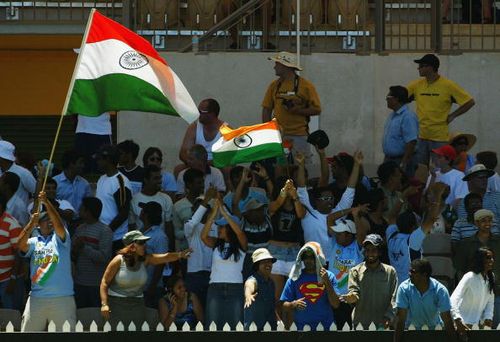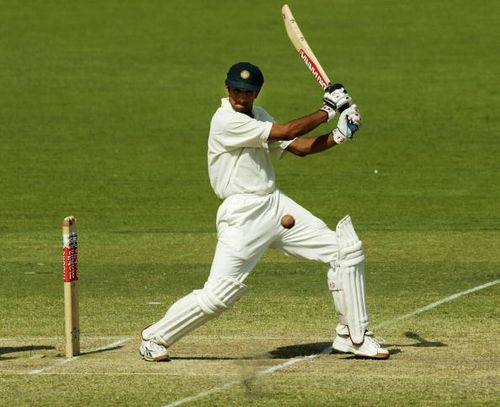
Adelaide 2003 - The story of those two breath-taking innings
Those 305 runs – 233 and 72 not out – changed the face of Indian cricket. Sourav Ganguly‘s Team India played like world-beaters, thanks mainly to “The Wall” who wore down the Australian attack and forced them into submission. When the Indian cricket team left for a compelling tour Down Under in 2004, they were expected to do comparatively better than their last visit in 1999, which had been catastrophic. After the rain-affected draw in the first Test match at Gabba, the second Test match belonged to Rahul Dravid who engineered a couple of knocks of sheer class. His defiance and warrior-like qualities helped India to register a win on the Australian soil after 23 years.
Rahul Dravid: 233 and 72* vs Australia, at Adelaide Oval, 2003-04

The Adelaide Oval scorecard told a tale which was hard to believe. On the fifth day of the second Test match, the Indian flags were flying high and it would have been easy for a person to (mistakenly) believe that the venue was Ahmedabad, and not Adelaide. The slogans “Jeetega bhai Jeetega India Jeetega” were heard all day long on the fifth day. The match was on Australian territory- but that day, Adelaide Oval was Dravid’s fortress. He had concocted and scripted one of the finest tales of modern era cricket. While concentration was the protagonist of the plot, the role of courage and grit was equally important. The villain, complacency, was conquered by the most striking feature of Dravid’s personality – courage.
A winning shot from Dravid’s bat would have been “the cherry on the top” moment. But Dravid took a single off Katich and levelled the scores. This act of altruism raised his bar as a cricketer. But Parthiv Patel got out and Dravid, it seemed, was destined to hit the winning runs.
Stuart MacGill was bowling to Dravid – and the scores were level. The ball was a tad short and wide.
Just about 72 hours ago, the Indian situation was fragile. At 85 for four, the follow-on seemed inevitable. India was still 471 adrift of the Australian total. It needed a “Herculean effort” for India to make a comeback. The Indian teams of the past buckled under such pressure. But this time they had someone whose batting was not appealing. It was like a work of art which rarely gets appreciation. The connoisseur of the art realizes the intricacies of the artwork – the presence of symmetric lines, the absence of the very obvious and the visibility of sweat and toil in the art. The batting of this man revolves around getting in line of the ball, playing as late as possible, divorcing himself from the pre-determined movements. No fussy, attractive moments. As simple as Dal Chawal (rice and dal). He is obscured by the fast-scoring, fancier batsmen many a time, but when he puts his head down and bats relentlessly, it is certain that Dravid will script a wonderful treatise. A Pulitzer Prize winning novel, if you will.
In the first innings, a 594-minute marathon innings was a perfect example of Dravid waging a battle with his inner-self. Dravid was battling to achieve synchronisation between the mind and the body. The ultimate goal was to attain that altitude of perfection. The battle was against his mind- which has the tendency to wander into the land of unknowns. But Dravid was in control of the “devil” inside his mind. When a forward defence shot was played, Dravid rehearsed that shot yet again. It was like recharging the battery- the water-tight technique of Dravid – and the signs were ominous for Australia.

Jason Gillespie, with his lopsided hair and tight leash line, was the bowler to watch out for on the third morning. Dravid negotiated his threat and in fact had the audacity to hook him for a six to bring about a wonderful hundred. When a part-time bowler like Katich came into the attack, Dravid’s concentration was at its peak.
Dravid’s 446-ball essay finally came to an end on the fourth morning. The innings depicted the fighting abilities of Dravid and his efforts had brought the Indian total within striking distance of the Australian score. India had indeed fought back well after being down and out. The bowlers then bowled out of their skins to dismiss Australia in two sessions. Ajit Agarkar bowled a once-in-a-lifetime spell, picking up six wickets. Dravid took two brilliant catches in the slips. It was amazing to see the levels of concentration of a man who was virtually on the field for four days.
A target of 230 was challenging considering the baggage of history. Indian batting had this uncanny knack of folding like a pack of cards under pressure. But Dravid’s best companion was discipline. Dravid let go a number of deliveries which were bowled at him outside his off-stump. Dravid was up against this task and had some nervy moments. But Gilchrist spilled a relatively easy chance and Dravid then became more determined. He was negotiating the attack with ease. A few wickets fell around him but he was like a determined mountaineer who was thinking only about the summit. When he got a short and wide delivery from MacGill with the scores level, Dravid promptly dispatched it to the boundary line. His immediate reaction was to raise his arms and kiss the Indian cap – which was achieved after years of perspiration and drudgery.
The Adelaide Odyssey triggered an Indian Renaissance. And it was inspired by a person who was labelled as a “blocker” in his early days.
On the occasion of his 40th birthday, I would like to say, “Thanks Dravid, for being the guiding light for the team at Adelaide.”